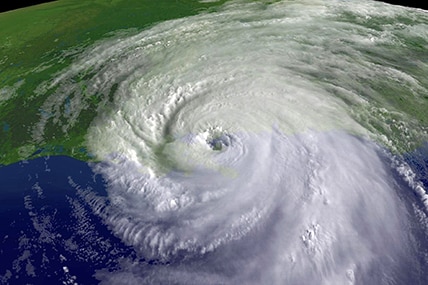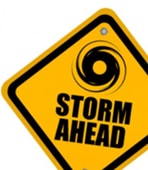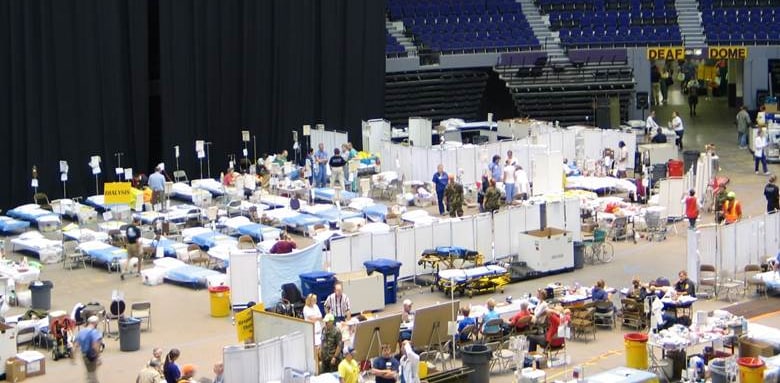NSSP Assists Emergency Response Efforts

The public health impact from hurricanes and tropical storms can be devastating and multifaceted. State and local health departments in areas likely to be affected by these natural disasters put considerable effort into developing emergency plans and resources to help communities prepare and respond. To understand the complexity of the impact—for example the disruption of infrastructure, storm-related injuries and illnesses, and displacement of people—public health practitioners need timely and actionable data.
During public health emergencies, state and local health departments that participate in CDC’s National Syndromic Surveillance Program (NSSP) use syndromic surveillance to capture data quickly, improve situational awareness, and inform decision making. Syndromic surveillance is often used in tandem with case-based surveillance systems and, during a hurricane response, can be readily integrated with other information such as weather and air quality data. During some phases of emergency operations, syndromic data can be the only available data source for identifying at-risk populations, monitoring use of healthcare resources, and verifying the effectiveness of response efforts in near real-time.
Syndromic surveillance is a well-proven way to collect prediagnostic data and, in recent years, has been creatively integrated with other data sources to better understand health threats. Collaboration across the surveillance community has produced an abundance of analytic tools, including interactive dashboards, that help public health analysts do their jobs even better and present information in ways decision makers can readily use.
Emergency and Risk Preparation
There’s no way to predict if a hurricane season will include a storm the size of Hurricane Harvey or back-to-back storms as destructive as Hurricanes Irma and Marie. That’s why a comprehensive emergency response plan for conducting surveillance should be in place before it’s needed.
So, how do CDC’s NSSP teams work with state and local health departments? Depending on availability of state and local resources, NSSP analysts, scientists, and epidemiologists can scale their level of support to provide narrowly targeted assistance or, on request, provide full-scale support through in-depth analyses.
Syndromic surveillance can serve as the cornerstone for emergency surveillance efforts. Core NSSP services include a suite of analytic tools for conducting surveillance and analyzing, storing, and sharing data for everyday surveillance and emergency response—all at no charge to public health departments. For years, the NSSP team has been working with states, large health departments, and territories to set up data feeds for healthcare facilities (e.g., emergency departments and urgent care centers). NSSP has also established connections with the Assistant Secretary for Preparedness and Response’s (ASPR) Disaster Medical Assistance Team’s (DMAT) electronic health record system so that feeds of data from deployed DMAT teams can be analyzed within NSSP systems along with all other data sources.
Here’s some insight into how NSSP supports health departments during a hurricane response:
Prepare—
- Once the path of a severe weather system has been identified, an NSSP team member will contact and offer support to participating state and local health departments. Depending on the health department’s needs, NSSP resources can be used to monitor surveillance activity or help facilitate communication, set up data access, and analyze data.

- If needed, NSSP will reconfigure established feeds to accept data from new sources.
- NSSP will verify that data use agreements are in place and clarify access privileges to local- or state-owned syndromic surveillance data.
- In collaboration with local and state health departments, officials at CDC, and other federal health agencies, NSSP can set up data-sharing groups.
- NSSP will coordinate with CDC’s Emergency Operation Center (e.g., communications, reporting) and, as needed, foster alliances with other CDC program staff, stakeholders, and federal agencies.
Respond—
- NSSP will monitor surveillance data to provide a national picture of the health threat and emergency response.
- When permitted by the states, NSSP will monitor their surveillance data. During past responses, most states and large health departments have given NSSP access to state or local data to improve situational awareness and better coordinate response efforts.

- When the NSSP team sees data anomalies, they’ll alert the state or local health department of these anomalies based on previous discussions about the level of support requested during an emergency response.
- NSSP will share findings with CDC’s Emergency Operations Center and, if requested, with other federal agencies. For example, NSSP has worked closely with the Federal Emergency Management Agency and ASPR during hurricane response efforts.
- If DMATs have been deployed, NSSP can monitor ad hoc data feeds from disaster relief or evacuation centers that provide emergency healthcare.
- Always, NSSP respects data-sharing agreements. When data are requested, NSSP facilitates access based on these agreements.
- On request, NSSP can help state and local health departments use syndromic surveillance to monitor the effectiveness of response activities.
- Combined, the NSSP team and community of practice have considerable experience. Experts are available to answer questions about surveillance, analytics, and data integration.
Recover—
- After the event, NSSP teams can work with community of practice participants to conduct after-action discussions and consider corrective actions and needed improvements. They will share best practices, lessons learned, new analytic techniques, and other information gleaned from the response activities. They will also share their response experiences through NSSP Community of Practice monthly meetings and NSSP emails, newsletter, and website.
- NSSP will deactivate data-sharing groups and access to data related to the emergency response.

Disaster epidemiology is the use of epidemiology to assess the short- and long-term adverse health effects of disasters and to predict consequences of future disasters. Typically, the main objectives of disaster epidemiology are to
- prevent or reduce the number of deaths, illnesses, and injuries caused by disasters,
- provide timely and accurate health information for decision-makers, and
- improve prevention and mitigation strategies for future disasters by gaining information for future response preparation.1
A comprehensive surveillance system uses syndromic surveillance in tandem with other surveillance methods, including case-based surveillance. In recent years, syndromic surveillance has expanded to include situational awareness, outbreak characterization, and resource allocation.2,3 Syndromic data are particularly useful for providing a baseline. Then, because syndromic data are captured in near real-time, analysts and epidemiologists can use these data to track trends against the baseline, contextualize likely post-disaster outcomes,2 and adjust response efforts during an emergency. After the response, syndromic surveillance can be used to monitor any delayed health outcomes.2 The NSSP team and participants in its community of practice continually share best analytic and surveillance practices and work together not only to advance the science but also to understand the human health impacts of a disaster.
- CDC. Disaster Epidemiology & Response: Frequently Asked Questions [Internet]. Atlanta: CDC; 2019 [cited 2021 Aug 12]. Available from: www.cdc.gov/nceh/hsb/disaster/faqs.htm
- Council of State and Territorial Epidemiologists (cste.org); Disaster Epidemiology Resource Guide. Chapter 2: Syndromic Surveillance and Disaster Epidemiology. Atlanta: CSTE; Jul 2021 [cited 2021 Aug 12]. Available from: DE_Resource_Guide_Final_v3.pdf (ymaws.com)
- Yoon PW, Ising AI, Gunn JE. Using Syndromic Surveillance for All-Hazards Public Health Surveillance: Successes, Challenges, and the Future. Public Health Reports [Internet]. 2017 Jul/Aug [cited 2021 Aug 12];132(Suppl), 3S–6S. doi: 10.1177/0033354917708995.
North Carolina Integrates Data from Disaster Medical Assistance Teams for Improved Situational Awareness
North Carolina collaborated with NSSP to collect data from emergency relief centers. The story includes an example of the Epidemiology and Surveillance Situation Report for Hurricane Florence (dashboard) and visualizations of syndrome and subsyndrome categories.
Syndromic Surveillance Shows Medical Surge in Dallas–Fort Worth during Hurricane Harvey, 2017
Texas public health officials used syndromic surveillance to show the expansive use of healthcare services extending outside areas most affected by the hurricane. Plans for medical surge capacity should extend to areas 1 to 4 hours outside the disaster area.
Monitoring Population Changes for Emergency Management Support in Tennessee
Tennessee health officials monitored emergency department visits of people displaced by the hurricane and seeking health care. Health officials found syndromic surveillance to be the only information source capable of rapidly collecting health data on out-of-state patients and assessing the impact on the healthcare system.
